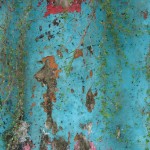This is not a condemnation of digital. I take great delight in it. Look at this, a wall, taken with my Digilux 2, and stitched together in Photoshop: it’s my masterpiece – so far. I could print it out, frame it, and stare at it the whole day. It’s Nature’s Mural. It is on my desktop now. I am very proud of it.

Wall. Leica Digilux 2, Panorama stiched in Photoshop
Or consider this one below, titled, “Orange, Red on Green”. This one made it into Leica Mastershots in the Leica Gallery, after rigorous selection by an expert panel, I am told on the website. This is a part of the same wall. I like it very much myself.

Orang, Red on Green. Selected for Leica Mastershots. Leica Digilux 2
But what do these mean? For my rolls of film, I hope to capture something of far greater import. For my digital studies in studium, I am keenly aware of their vanity.
5. Infallible Propositions
Here’s a random thought, that I’ve been nursing this couple of days.
Recall that Descartes suggested that one’s doubting is indubitably true, since, by doubting one’s doubt, one is still doubting. So as long as I doubt, that I am doubting, is infalliby true – for even when one doubts that, one proves it is true performatively.
Here’s a more thomistic example, from John Finnis: suppose someone says that knowledge is a good, but is confronted with the skeptical challenge that it is not – well, the skeptical challenge, when not whimsical but careful and considered, even rigorous, ironically demonstrates or proves that ‘knowledge is a good’ to be true, or contradicts the very skepticism, since one is here keen, when skeptical, to grasp the good of the truth of knowledge, namely the knowledge of whether knowledge is true or false, or to promote as a good, the knowledge that ‘knowledge is not a good’. (Finnis, 1980: 74-75)
Suppose I say that, Photography affords, semiosically, ethical or religious (to the extent that religiously based moral ideas can be classified as ‘ethical’) consciousness raising. By this I mean that photography, which includes everything I do here – the taking of pictures, the captioning, the blogging or writing about it, etc. – has the capacity to lead, as a sign-post, to ethical or religious ideas, either by reminding us of these, or by pressing us to think about the latter, or by holding up the latter to our consciousness when otherwise we would not bother with them. So:
“Photography (Ph) affords Ethical (E) consciousness raising, by way of semiosis”
This seems to me infallibly correct, using infallibility in loose way, to suggest that the very posing of this proposition as a question, i.e., “Does: photography afford ethical consciousness raising by way of semiosis?” itself adds to its truth.
Proof:
Let P be (Ph affords E semiosically)
Interrogate, question, problematize P.
Hence, {Is it true that P?}
Let ?P be the problematization, the skeptical questioning, or the research question in relation to P.
I.e., Let ?P be {Is it true that P?}
How are ?P and P related?
?P asks if P is True.
Now, because through the posing of the question, Ph and E are held up semiosically, hence Ph does afford E.